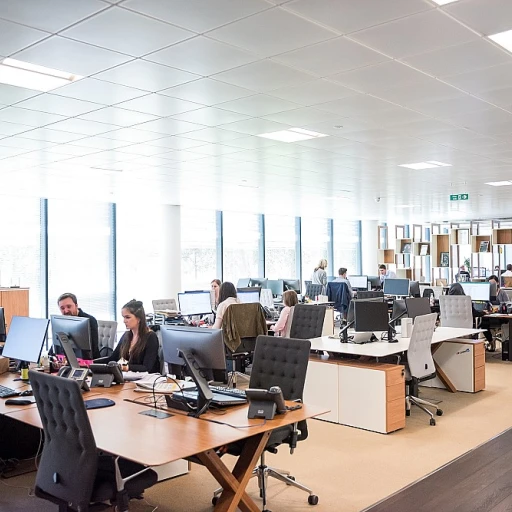
Assessing Your Office's Environmental Footprint
Analyzing Your Business's Carbon Contributions
Understanding your office's environmental footprint is much like conducting a symphony of eco-consciousness: it requires a detailed analysis of each section to create a harmonious sustainability performance. Offices have traditionally contributed significantly to carbon emissions, energy consumption, and waste. Today's office management strategies stress the importance of reducing this footprint. According to a study by the Carbon Trust, office-based businesses can reduce energy costs by up to 20% simply through energy efficiency measures, a statistic that underlines the pressing need for attention in this area.
Smart Metrics for a Greener Office
To truly peg down your office's impact on the environment, you must delve into specifics. Comprehensive statistics such as the amount of paper waste generated, the kWh of energy consumed, and the gallons of water used are crucial. Incorporating eco-friendly office practices, like monitoring these metrics, leads to informed decisions and serves as the foundation of a sustainable office culture and economical operations. As Jennifer Howard, a renowned energy analyst, aptly states, "What gets measured gets managed."
Implementing an Effective Resource Management System
With accurate data, implementing eco-friendly measures becomes more streamlined. For instance, streamlining these procedures could include moving towards a digital document management system to reduce paper waste, a move backed by the significant statistic that the average office worker uses 10,000 sheets of paper annually, according to the Environmental Protection Agency (EPA). By integrating a resource management system, not only is document handling made more efficient, but it also contributes to a considerable decline in your environmental footprint.
Employee Engagement in Sustainable Practices
Without engagement at all levels, even the best-laid plans for sustainability can fall flat. Initiating programs that encourage and reward employee participation in reducing the office's environmental footprint can create integral changes. Example initiatives such as 'Ride to Work' schemes or 'Paperless Fridays' can yield both enthusiasm and measurable results. An effective office manager understands that cultivating an eco-friendly workplace is a collective endeavor, and engaging employees in this journey is not only beneficial for the environment but also promotes a sense of community and shared purpose within the office.
Strategies for a Sustainable Office Culture
Understanding Your Office's Carbon Footprint
In the pursuit of eco-friendly practices, the first step any Office Manager should take is understanding the environmental impact of their workspace. Conducting an audit on your office's carbon footprint unveils the extent of energy consumption, waste generation and helps pinpoint areas for improvement. Recent statistics indicate that office buildings account for a staggering 19% of energy consumption in commercial sectors, highlighting the urgent need for sustainable measures (U.S. Energy Information Administration). By leveraging energy audits and footprint calculators, Office Managers can set well-informed benchmarks.
Establishing a Baseline for Green Performance
By consolidating data such as utility bills, supply purchasing habits, and recycling statistics, one can establish a quantitative baseline for green performance in the office. It's a practice endorsed by top management analysts to strategize efficiently towards eco-friendly workplace solutions. For example, a report by the World Green Building Council suggests that green office spaces can reduce energy consumption by up to 50%. This emphasizes the potential for significant cost savings while nurturing an ecologically responsible office environment.
Measuring Impact Beyond Energy
While energy consumption forms a majority of an office's environmental footprint, it's crucial to consider other factors such as water usage, waste disposal, and the sourcing of sustainable office supplies. In the vein of comprehensive scrutiny, the Office Manager's role extends to sustainable office culture and operation. Did you know that according to the Environmental Protection Agency, the average office worker uses 10,000 sheets of copy paper each year? That's a footprint to be reckoned with, hence the need for meticulous waste management and recycling protocols.
Insights from Green Leaders
Striving towards an eco-friendly workplace, many offices can take a leaf out of the book of green leaders such as Google and Salesforce, which have embraced the sustainable office ethos to remarkable effect. These industry giants exemplify how technological innovations and company-wide sustainability commitments can harmoniously lead to reduced environmental impact while boosting employee morale and brand reputation.
Recognizing the Role of Employees in Office Sustainability
It's not all about policy and tech—sustainability is also a team effort. As an Office Manager, fostering an inclusive eco-smart office culture where employees are encouraged to contribute to green initiatives can have a tremendous impact. Adopting simple habits such as turning off electronics when not in use or promoting a paperless environment can be transformative. A study by McKinsey & Company reveals that companies that engage employees in sustainability efforts see a 27% increase in employee loyalty. These shared responsibilities culminate in a collective stride towards a brighter, greener future.
The Economical Edge of Going Green
Instilling Sustainability as a Core Value
Building a sustainable office culture is pivotal to reducing your environmental impact. According to statistics, adopting eco-friendly practices not only supports the planet but also enhances employee morale. A study by the University of California revealed that sustainable offices report a 16% increase in employee productivity. To instill these practices, start with an office sustainability commitment. This pledge should be woven into all job roles and responsibilities, fostering a shared sense of accountability for the environment.
Green Policies that Make a Difference
- Implement a company-wide recycling program.
- Encourage a paperless work environment through digital solutions.
- Adopt power-saving measures such as LED lighting and smart thermostats.
Energy-saving measures can lead to substantial cost savings. For instance, LED lighting cuts energy usage by up to 80%, according to the U.S. Department of Energy. These green policies serve as a testament to a company's dedication to sustainability, creating a ripple effect that extends beyond the office walls.
Engaging Employees in Sustainable Practices
Success in green initiatives is often a result of employee engagement. Create a green team or sustainability committee to champion these initiatives. Offer incentives for eco-friendly behaviors like carpooling, biking to work, or reducing personal waste. These strategies not only promote sustainability but also build a tight-knit community within the office. An article by the Harvard Business Review underlines the importance of engaging employees in sustainability, highlighting that it can lead to innovative solutions and enhanced loyalty.
Education and Awareness: The Foundations of Change
Education is a cornerstone of sustainable development. Host workshops and seminars to highlight the importance of eco-friendly practices. Celebrate milestones such as Earth Day or participate in local sustainability events. By raising awareness, employees become more conscientious of their daily habits and the impact they have on the environment. The Natural Resources Defense Council (NRDC) emphasizes the role of education in promoting sustainability, sharing that informed individuals are the most likely to adopt environmentally friendly behaviors.
Continuous Improvement and Sustainability Reporting
Develop metrics to measure the effectiveness of your sustainability initiatives. Tools like carbon footprint calculators help track progress. Regularly report these findings to keep the team motivated and informed. Such transparency is crucial, as McKinsey & Company reports that 70% of consumers believe transparency is important in how companies source their materials. Ultimately, by showcasing continuous improvement in sustainable office management, companies can not only attract eco-conscious consumers but also inspire other businesses to follow suit.
Technological Innovations for Eco-Smart Offices
The Financial Benefits of Eco-Conscious Operations
Embracing eco-friendly practices isn't just about protecting the environment; it's also about securing an economical advantage for your business. Statistics demonstrate significant cost reductions when offices transition to green solutions. For example, according to the U.S. Environmental Protection Agency, energy efficiency can save businesses up to 30% on their utility bills. By investing in energy-saving technologies and practices, office managers can witness a substantial decrease in overhead expenses. Utilizing natural light, upgrading to LED lighting, and adopting energy-efficient appliances are practical steps towards achieving a leaner and greener financial operation.
Maximizing Profits Through Waste Reduction
Another facet of the economical edge is waste reduction. Cutting down on unnecessary paper use, for instance, not only supports a sustainable office culture but also translates to direct savings on supply costs. As reported by Forbes, companies can save nearly $80 per employee annually by transitioning to digital documents and tools, highlighting the potential return on investment when integrating eco-friendly measures. Moreover, engaging employees in recycling programs ensures both material costs and environmental impact are minimized, showcasing a commitment to eco-friendly office management that also boosts the company's bottom line.
Investing in Renewable Energy: A Long-Term Asset
Going beyond day-to-day savings, offices that invest in renewable energy sources like solar or wind power position themselves for enduring economic benefits. Initial installation costs are often offset by long-term reductions in energy expenditures, with the added advantage of government incentives and tax breaks for businesses adopting sustainable practices. The International Renewable Energy Agency reported that renewable power is increasingly cost-competitive, making it an economically savvy choice that aligns with global sustainability trends while improving a company's financial profile.
Cultivating a Green Brand Identity
Last but not least, the shift towards an eco-friendly workplace feeds into positive brand identity, which has a definitive impact on the company's profitability. Consumers are showing a strong preference for environmentally responsible companies, with Nielsen studies indicating that 66% of global consumers are willing to pay more for sustainable brands. A green office exemplifies corporate social responsibility, which can enhance customer loyalty and open up new market opportunities, ultimately leading to increased revenue streams and market-share growth.
Overcoming Challenges to Implement Eco-Friendly Measures
Revolutionize Your Workplace with Cutting-Edge Green Tech
In the journey towards an eco-friendly workplace, technology plays a pivotal role. Innovative solutions are making waves, significantly reducing energy consumption and carbon footprints. Implementing such technologies not only supports sustainability but also positions companies as modern and environmentally conscious .
Smart Systems: Harnessing Automation for Energy Efficiency
Current smart office trends extend beyond mere convenience. Smart lighting systems, which utilize LED bulbs coupled with occupancy sensors, can slash energy use by as much as 80%, according to the U.S. Department of Energy. Meanwhile, smart thermostats learn heating and cooling patterns, optimizing climate control and can reduce HVAC costs by 10-30%, as noted by the EPA.
- LED Lighting Combined with Advanced Sensors
- Programmable Thermostats for Optimal Climate Control
- Energy Management Software for Detailed Tracking
The Rise of Green Computing in the Modern Office
With data indicating that data centers will account for 3.2% of global CO2 emissions by 2025, green computing has become a necessity. Eco-friendly servers, energy-efficient storage options, and cloud-based solutions are becoming the norm, dramatically decreasing the carbon footprint of digital operations. Harnessing the power of the cloud not only reduces the need for physical infrastructure but also increases data accessibility, boosting both sustainability and productivity.
Embracing Renewable Energy Sources for Maximum Impact
Renewable energy systems, such as solar panels and wind turbines, are becoming more affordable and accessible for businesses. According to the International Renewable Energy Agency (IRENA), the cost of solar photovoltaics has fallen by about 82% since 2010, making it more feasible for offices to invest in their own renewable energy sources. This transition not only curbs reliance on fossil fuels but also provides long-term economic benefits.
Overhauling Obsolete Equipment: Investing in the Future
Outdated office equipment not only hampers productivity but is also detrimental to environmental efforts. Replacing these with energy star-rated appliances can lead to substantial savings and a smaller ecological footprint. For instance, ENERGY STAR certified products can save businesses nearly $450 billion and prevent more than 3.5 billion metric tons of greenhouse gas emissions over the next 15 years, showcasing the profound impact of choosing the right equipment.

-large-full.webp)

